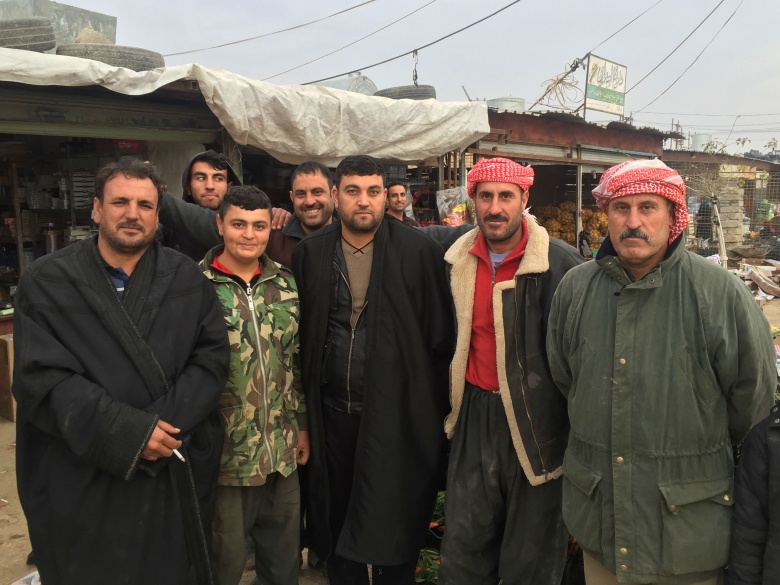The Yazidi shopkeepers in Snuny, in northern Iraq, have a warmth about them that belies their circumstances. A year ago their town was liberated from ISIS by Kurdish peshmerga forces. The hope was that some of the 250,000 Yazidis who fled ISIS after the extremist group began massacring them and selling women into slavery would return to these tranquil plains. But the men, and it’s mostly men who have come back to tend their shops, say life here is impossible. “It’s very difficult to speak of the future. We were surrounded by Arabs, we are afraid of them returning,” says forty-year-old Hussein. “This is still a military zone, there is no electricity, we have nothing.”
In August of last year ISIS swept across northern Iraq, conquering thousands of square kilometers, an area approximate in size to the state of Connecticut. The extremist group had already taken over many of Iraq’s large Sunni cities, such as Mosul, Tikrit and Falluja between January and June 2014. Mount Shingal (“Sinjar” in Arabic) in northern Iraq is the center of this large district, which was home to diverse groups, including 250,000 members of the minority Yazidi faith. The religion of this group is not open to outsiders, but its origins are indigenous to Iraq and has diverse influences, including Islamic Sufi traditions. For hundreds of years, the group has been persecuted by Sunni Islamic rulers and accused of being heretics. Many Yazidis describe these persecutions as seventy-three individual genocides. They consider the mass killing by ISIS in 2014 as the seventy-fourth.
When ISIS established itself in Mosul, it gained a reputation for brutal persecution of minorities. Christians were ordered to convert or leave and their houses were marked with an Arabic letter “N.” According to locals, the Iraqi army abandoned its positions before ISIS invaded Shingal, leaving behind Kurdish peshmerga. ISIS advance was aided by having captured two brigades’ worth of Iraqi army military equipment just before August.
This large area had been disputed between the Kurdish Regional Government and the Iraqi central government before 2014. Some Yazidi men had previous experience fighting alongside Kurds during the rebellion against Saddam Hussein, and in the 1990s. One of those was Qasim Sheshu. Born in 1953, Sheshu maintains his headquarters near the Sherfedin shrine which sits just below the south slopes of Mount Shingal. A burly man with an ample mustache, he describes being awoken at 3:30 am on August 3, 2014 with reports that ISIS was attacking all over the district. Along with a handful of other Yazidis, he tried to resist the ISIS advance. Many Yazidis had heard through friends that extremists in Mosul and Tal Afar had already begun killing Yazidis. Several unlucky villages were overrun by ISIS after local Arabs who supported the extremists told the minority group not to flee, that everything would be fine. Many of those I spoke to recall this local collaboration as a factor that has forever changed their feelings of security here.
Sheikh Nasser Pasha, a Kurdistan Democratic Party (KDP) official in liberated Shingal town and former commander who fought ISIS in the mountains, says that ISIS arrived with “this Islamist idea of superiority and fascism, like Hitler and Mussolini, they killed them [Yazidis] for their religion and also because [Yazidis] are Kurdish.”
Although most Yazidis ended up in refugee camps, around 85 percent of the people according to Vian Dakhil, a Yazidi member of Iraq’s parliament, some 20,000 remained behind on Mount Shingal. Today the tents these refugees live in can be seen dotting the valleys and along the main road. The circumstances of the refugees are wretched. Khansa Shamdin, a Kurdish surgeon from Syria who volunteered to come to the mountain in September 2014 by helicopter, runs a small free health clinic for local people. Around 120 a day make the long journey to the clinic, which is in a caravan, but they say that besides this they receive little to nothing from the international community.
After Kurdish peshmerga forces, with some 8,000 Yazidi volunteers among them, retook Shingal town in November, there was hope that some of the refugees would return. But a closer look reveals that the town is in total ruins. Explosive devices left behind by ISIS, which created a network of tunnels to obscure their positions, are being cleared daily. There are still some 100 Yazidi villages and hamlets in the hands of ISIS where 150,000 people once lived.
“They want to come back,” says Sheshu, “but only if someone will help rebuild this area and we receive weapons to defend it.” Many Yazidis who have tried to stay here, such as Sheshu, Nasser and the shopkeepers, are dismayed that their coreligionists are fleeing to Europe. Some called them “cowards,” but others had sympathy. “The positive thing from this war is that many people [choose to] fight and struggle to defend their land. The negative is that many are fleeing to Europe,” says Nasser.
 Geostrategic Media Political Commentary, Analysis, Security, Defense
Geostrategic Media Political Commentary, Analysis, Security, Defense





